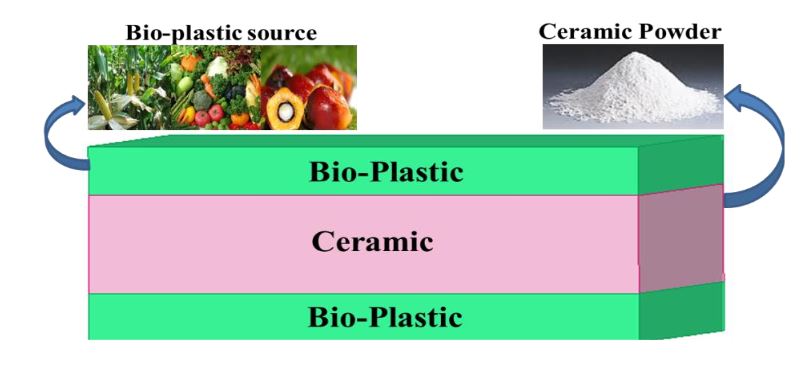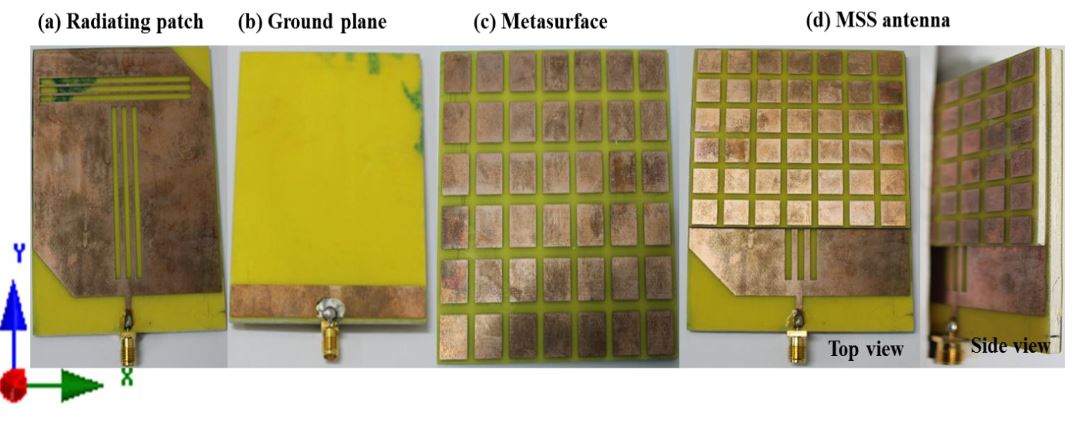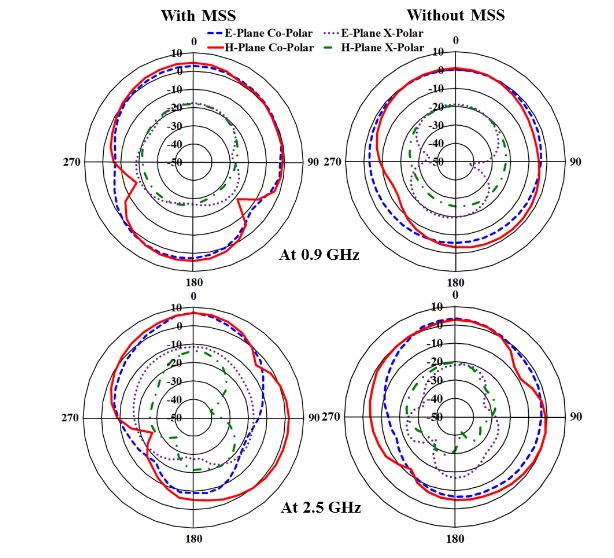ABSTRACT
A new metasurface superstrate structure (MSS)-loaded dual band microstrip line-fed small patch antenna is presented in this paper. The proposed antenna was designed on a ceramic-filled bioplastic sandwich substrate with a high dielectric constant. The proposed 7 × 6 element, square-shaped, single-sided MSS significantly improved the bandwidth and gain of the proposed antenna.
The proposed MSS incorporated a slotted patch antenna that effectively increased the measured operating bandwidth from 13.3% to 18.8% and from 14.8% to 23.2% in the lower and upper bands, respectively. Moreover, the average gain of the proposed MSS-based antenna was enhanced from 2.12 dBi to 3.02 dBi in the lower band and from 4.10 dBi to 5.28 dBi in the upper band compared to the patch antenna alone.
In addition to the bandwidth and gain improvements, more directive radiation characteristics were also observed from the MSS antenna compared to the patch itself. The effects of the MSS elements and the ground plane length on the reflection coefficient of the antenna were analyzed and optimized. The overall performance makes the proposed antenna appropriate for RFID and WLAN applications.
DESIGN AND CONFIGURATION

Figure 1. Substrate material structure
Figure 1 shows the proposed sandwich-structured substrate material that was prepared using the bioplastic and ceramic powder. The assorted ceramic powder with a polymeric binder was sintered using the polymeric sponge method, which involves the use of 9.8 mils (0.25) biopla stic sheet from organic biomass sources, such as vegetable oil, cornstarch and palm oil, as the ceramic cover. The three-layered bioplastic-ceramic-bioplastic sandwich structure was laminated with 35 μm of copper foil.

Figure 8 . Photograph of fabricated prototype of (a) radiating patch; (b) ground plane; (c) metasurface; and (d) metasurafce superstrate loaded antenna
The proposed slotted patch antenna with a metasurface superstrate was prototyped using a LPKF in-lad PCB prototyping machine for verification of the performance results. Figure 8 shows a photograph of the fabricated prototype (a) radiating patch; (b) ground plane ; (c) metasurface superstrate; and (d) proposed metasurface superstrate-loaded antenna. A 10 mm long and 2 mm wide microstrip line is used for feeding to meet the standard 50 Ω impedance characteristics.
RESULTS AND EXPERIMENTAL VERIFICATION

Figure 11. Measured radiation pattern of the antenna at both resonant frequencies with and without MSS
The measured E and H plane radiation patterns for the proposed antenna in both the lower and upper resonant frequencies, 0.9 GHz and 2.5 GHz, respectively, with and without the MSS are shown in Figure 11. In addition to the bandwidth and gain enhancements, the MSS-incorporated antenna exhibits more directional radiation characteristics than that without MSS; these effects are not desired for RFID and WLAN applications.

Figure 12 . Surface current distribution of the proposed antenna with and without MSS at both lower and upper resonant frequencies
The broadside beamwidth of the MSS-loaded antenna decreases compared to the patch antenna alone, and as a result, the directivity is increased. Moreover, the backward radiation is slightly higher, but such an effect can be caused by a poor cable connection between the antenna and the controller. The surface current distribution of the proposed antenna is shown in Figure 12. From the surface current distribution, it can be observed that the excited power flow is stronger and consistently in the upper band compared to the lower band.
CONCLUSION
A new single-sided metasurface superstrate-loaded dual band patch antenna on a high permittivity ceramic-filled bioplastic sandwich-material substrate was designed and analyzed for bandwidth and gain enhancements. A prototype of the proposed antenna was fabricated and measured for experimental verification. Based on the measurement results, substantial improvements in the bandwidth and gain were realized. The MSS superstrate-loaded antenna widened the operating bandwidth from 120 MHz to 170 MHz and from 370 MHz to 580 MHz for the lower and upper bands, respectively.
Moreover, the measured average gain improved from 2.12 dBi to 3.02 dBi in the lower band and from 4.10 dBi to 5.28 dBi in the upper band. In addition to the bandwidth and gain enhancements, the MSS-integrated antenna exhibits a more directional radiation pattern compared to the patch antenna alone. A parametric analysis of the MSS element sets and ground plane length of the patch antenna was conducted. The input impedance and VSWR of the proposed antenna have further validated the use of the Smith chart.
Source: University Kebangsaan Malaysia
Authors: Mohammad Tariqul Islam | Mohammad Habib Ullah | Mandeep Jit Singh | Mohammad Rashed Iqbal Faruque
>> Antenna Design Based Projects List for Engineering Students
>> 60+ Project Report on Microstrip Patch Antenna for Final Year Students